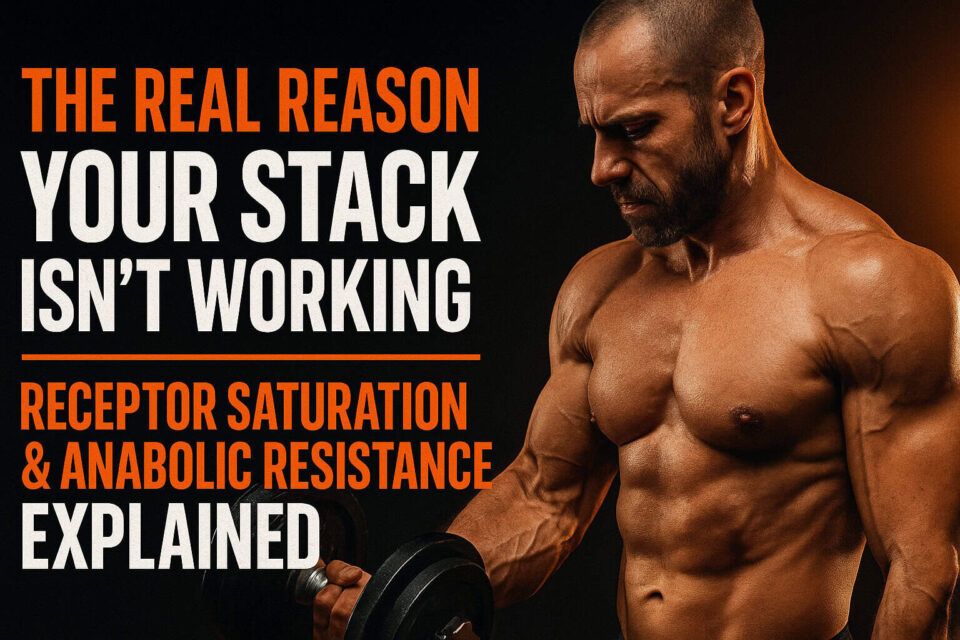The Real Reason Your Stack Isn’t Working: Receptor Saturation & Anabolic Resistance Explained
You’ve got your compounds dialed in. You’re training hard. You’re eating like a machine. But for some reason… your physique hasn’t changed in weeks.
Sound familiar?
There’s a dirty little secret in the enhanced bodybuilding world that hardly anyone talks about: receptor saturation and anabolic resistance. In other words, the problem might not be your stack—it might be that your body simply isn’t responding to it anymore.
This guide breaks down exactly what’s happening, why, and what to do about it—so you can get back to growing.
🧬 What Is Receptor Saturation?
When you introduce anabolic compounds like testosterone, trenbolone, or nandrolone into the body, they bind to androgen receptors (ARs) inside your cells. This is what triggers the cascade of effects that lead to muscle protein synthesis, strength gains, and enhanced recovery.
But here’s the catch: those receptors aren’t infinite.
Your body only has so many androgen receptors at a given time, and once they’re full, there’s nowhere else for additional compounds to bind. This is called receptor saturation—and it’s one of the most overlooked reasons a well-designed stack suddenly stops producing results.
🧱 Anabolic Resistance: When More Doesn’t Mean Better
Even worse than saturation is anabolic resistance, where your body begins to adapt to high levels of anabolic signaling and downregulates its response. In practical terms?
- Gains slow to a crawl
- Pumps are weaker
- Strength plateaus
- Recovery starts lagging
This is not just about bad luck or genetics. It’s a biological defense mechanism. Your body resists staying in a constant hyper-anabolic state.
🚫 The “More Gear” Trap
The mistake most lifters make? Adding more compounds or increasing the dose.
- 500 mg/week isn’t working? Let’s go to 750.
- Still flat in the gym? Add some Dbol.
- Strength stalling? Throw in Tren.
What this does is increase androgen load without increasing receptor availability—which only makes the resistance worse. You’ll start seeing more side effects with fewer returns.
🧠 The Real Fix: Sensitize, Don’t Just Stimulate
You don’t need more. You need to become more responsive.
Here’s how elite lifters, coaches, and researchers are now approaching anabolic resistance:
1. Use Binding-Specific Compounds Smartly
Different compounds bind with varying affinities:
- Testosterone: Moderate
- Trenbolone: Very high AR binding
- Anavar: Mild
- Masteron: Binds tightly, but with anti-estrogenic edge
Rotating or strategically stacking can prevent one pathway from becoming overly saturated.
2. Run Clean Periods (Blast & Cruise or True Off Cycles)
Give receptors time to reset. Even if you’re cruising, bringing doses down for 6–10 weeks can re-sensitize pathways.
3. Microdosing & Split Injections
More frequent, lower-dose injections (e.g., EOD or every 3.5 days) help maintain stable hormone levels, reducing stress on the ARs.
4. Use Peptides or GH to Complement, Not Compete
Some peptides like IGF-1 LR3 or GH work downstream, without taxing the ARs. This provides an anabolic signal from a separate pathway.
🧪 Bloodwork Markers to Monitor
Want proof that your body’s adapting? Look at these markers:
- SHBG (Sex Hormone Binding Globulin): Too low = overexposure
- LH/FSH: Flatlined for months? Receptor burnout is likely
- Free Test vs Total Test: A big gap here shows saturation
✅ How to Regain Sensitivity and Start Progressing Again
Here’s a proven 8-week protocol used by pros to regain anabolic sensitivity:
| Week | Strategy |
|---|---|
| 1–2 | Drop all injectables to TRT or come off completely |
| 3–4 | Add GH or peptides (e.g., BPC-157, IGF-1 LR3, TB-500) |
| 5–6 | Introduce lighter androgens (e.g., Primo, Anavar) |
| 7–8 | Reintroduce base test and a moderate secondary compound |
Throughout: Clean diet, prioritize sleep, and train with intent but reduce overall volume to minimize systemic stress.
Final Thought: Build a Body That Responds
If you feel like you’re doing everything right—but your stack has stopped working—it’s not a willpower issue. It’s likely a receptor and adaptation issue. Pushing harder won’t fix it. Getting smarter will.
Rebuild your response. Then reintroduce your stack. That’s how the pros do it.




